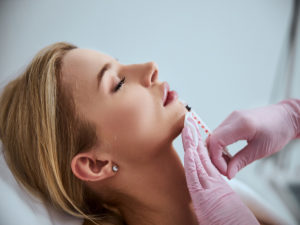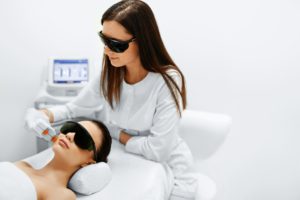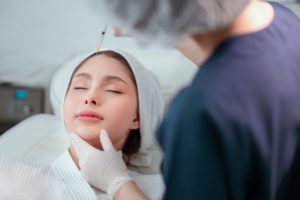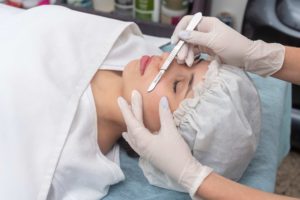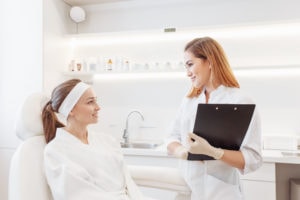
Dermal fillers have surged in popularity in recent years, offering individuals an array of non-invasive options to enhance their facial features and regain a youthful appearance. These cosmetic procedures have become a cornerstone of the beauty industry, from plumping up lips to softening wrinkles. However, behind the allure of revitalizing one’s appearance lies a fundamental question: How safe is it to go for dermal fillers?
Safety is important in any cosmetic procedure, and dermal fillers are no exception. In this blog, we will delve into the world of dermal fillers, examining the key factors that ensure their safety. Join us as we navigate the realm of dermal fillers and discover the measures to make these treatments safe and effective.
What are dermal fillers?
Dermal fillers are cosmetic products used to restore volume and fullness to the face, reducing the appearance of wrinkles, fine lines, and hollow areas. They typically comprise safe, biocompatible materials injected beneath the skin’s surface. The primary objective of dermal fillers is to plump and rejuvenate the skin, providing a more youthful and vibrant look without invasive surgery.
These fillers can address various concerns related to facial aging, such as:
- Wrinkles and Fine Lines: Dermal fillers can effectively diminish the appearance of smile lines, marionette lines, and other facial wrinkles.
- Loss of Volume: The face can lose volume as we age, leading to a sagging or hollow appearance. Dermal fillers can restore lost volume to cheeks, temples, and under the eyes.
- Lip Enhancement: Many individuals opt for dermal fillers to enhance lip fullness and definition.
- Scarring: Dermal fillers can also be used to minimize the appearance of scars, such as those caused by acne or injury.
What are the common uses for dermal fillers in aesthetics?
The aesthetic uses of dermal fillers are diverse, making them a versatile option for individuals seeking non-surgical facial enhancements. Some of the common uses include:
- Lip Augmentation: Dermal fillers can provide fuller and more defined lips, addressing concerns about thin or asymmetrical lips.
- Cheek and Mid-Face Volumization: Fillers can restore volume to the cheeks and mid-face, creating a youthful, lifted appearance.
- Nasolabial Folds and Marionette Lines: These products can soften and reduce the appearance of deep creases around the mouth, creating a smoother complexion.
- Under-Eye Hollows: Dermal fillers can minimize the appearance of dark circles and hollows under the eyes, reducing the tired look.
- Non-Surgical Rhinoplasty: Fillers can reshape and enhance the nose’s appearance without surgical intervention.
- Acne Scar Treatment: Certain dermal fillers can improve the appearance of acne scars and other types of facial scarring.
By providing an overview of dermal fillers and their common aesthetic applications, individuals can better understand the possibilities these treatments offer for facial rejuvenation.
What are dermal fillers made of?
Dermal fillers consist of a variety of ingredients, with each type offering unique characteristics and applications. One of the most common ingredients found in dermal fillers is hyaluronic acid.
Hyaluronic acid is a natural substance in the skin, joints, and connective tissues, making it highly compatible with the human body. Dermal fillers harness its ability to retain moisture to hydrate and volumize the skin.
Is this ingredient safe?
The ingredients found in dermal fillers are carefully selected for their safety and compatibility with the human body. Hyaluronic acid is a naturally occurring substance that minimizes the risk of allergic reactions or adverse effects. This makes hyaluronic acid-based fillers a popular choice among patients and practitioners alike.
The biocompatible nature of these ingredients ensures that the body can gradually absorb them over time. This characteristic not only contributes to the safety of the treatment but also allows for adjustments or maintenance as needed.
Before undergoing dermal filler treatments, discussing your options with a qualified practitioner like those at Beauty Nurse Bre, who can recommend the most suitable filler type based on your specific goals and individual characteristics, is essential. This ensures a tailored approach to enhance natural beauty while prioritizing safety and well-being.
Why is it important to choose a qualified practitioner?
The choice of a qualified practitioner plays a pivotal role in ensuring the safety and success of dermal filler treatments. These skilled professionals are well-versed in aesthetics and possess in-depth knowledge of the various dermal filler products, their applications, and the nuances of the human anatomy. Here’s why their role is indispensable:
1. Expertise in Product Selection: Qualified practitioners understand the diverse range of dermal fillers available and can select the most appropriate one for your needs. They consider factors like the type of filler, the area to be treated, and your desired results.
2. Precise Application: Injecting dermal fillers is delicate and precise. An experienced practitioner knows the correct injection depth, technique, and volume required to achieve the desired outcome while minimizing risks.
3. Safety Protocols: Trained practitioners follow strict safety protocols to minimize the risk of complications. They are prepared to address any potential adverse reactions promptly and effectively.
4. Hygiene and Sterility: A qualified practitioner operates in a clean, sterile environment, reducing the risk of infections or complications.
5. Natural-Looking Results: Skilled practitioners aim for results that enhance your natural beauty, not alter it dramatically. They prioritize achieving a balanced and harmonious appearance.
Are there any side effects?
While dermal fillers offer impressive results for facial rejuvenation, it’s crucial to be aware of the potential risks and side effects accompanying these treatments. Understanding these possibilities is essential for making an informed decision.
Common side effects may include:
- Temporary Swelling and Bruising: It’s common to experience some swelling and bruising at the injection site. This usually subsides within a few days to a week.
- Redness: Mild redness and tenderness are typical but typically resolve quickly.
- Lumps or Bumps: Minor lumps or bumps may occasionally develop under the skin. These are typically temporary and can be massaged out or resolved with the help of your practitioner.
It’s essential to note that adverse reactions are uncommon, and the majority of individuals who receive dermal filler treatments do so without any issues.
Prioritize Your Safety and Consult with Professionals like Beauty Nurse Bre
Remember that safety should be your unwavering companion as you consider the path to a more youthful and vibrant appearance. The expertise of a qualified practitioner, careful consideration of potential risks, and adherence to guidelines significantly contribute to your well-being during and after dermal filler treatments.
At Beauty Nurse Bre, our commitment to your safety and satisfaction is unwavering. Our experienced professionals, along with the latest advancements in the field, ensure that your journey to a more radiant you is not only transformative but also secure.
Prioritize safety, prioritize yourself. Contact us at Beauty Nurse Bre for your dermal filler needs. We are here to guide you, provide safe and effective treatments, and help you achieve your desired confidence and beauty.
Your journey to a more youthful, refreshed appearance is a voyage to be embarked on with wisdom and care. Trust in your safety, and trust in us to be your dedicated partners in this remarkable transformation.
